|
|
|
Sort Order |
|
|
|
Items / Page
|
|
|
|
|
|
|
| Srl | Item |
| 1 |
ID:
192658
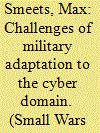

|
|
|
|
|
| Summary/Abstract |
Whilst NATO speaks increasingly publicly about the military use of cyber operations, adaptation to the cyber domain has reportedly been challenging for most militaries. Little research has sought to understand the nature of these challenges. This study seeks to address this gap through a case study of the Netherlands. By utilizing a range of primary and secondary sources, this article reveals that the Dutch Defense Cyber Command has faced significant constraints in its adaptation to the cyber domain, primarily due to issues related to organizational structure, operational mandate, and the availability of skills and resources. A cyber command that lacks regular opportunities for day-to-day operations and where personnel may not have continuous learning opportunities to acquire and refine their skills will encounter difficulties in recruiting, training, and retaining a proficient workforce. These findings highlight the tendency of observers to mistakenly equate the mere establishment of a cyber command with the existence of a robust military cyber capability – namely, the ability to effectively carry out and sustain a range of cyber operations for tactical or strategic purposes.
|
|
|
|
|
|
|
|
|
|
|
|
|
|
|
|
| 2 |
ID:
192659
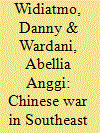

|
|
|
|
|
| Summary/Abstract |
Kokang is an ethnic minority group that settled along the Myanmar-China borderland with dual identity as it has long historical ties of nationalism and patronage with various political factions in China while located outside China’s border. This article explores how Kokang’s Ethnic Revolutionary Organization (ERO), the Myanmar National Democratic Alliance Army, and their leaders construct Kokang’s identity to their benefit. Based on desk research method, the article found that Kokang’s dual identity allows them to self-categorize themselves as Chinese or separate-independent ethnic minorities in Myanmar while setting ethnic boundaries with various political entities to protect their interest.
|
|
|
|
|
|
|
|
|
|
|
|
|
|
|
|
| 3 |
ID:
192656
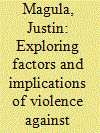

|
|
|
|
|
| Summary/Abstract |
The Soviet-Afghan War serves as a significant case study to understand why states resort to violent acts against civilians during war. This study takes a multidimensional approach, examining strategic, operational, and individual factors and applying theories of violence and mass killing. By analyzing the conditions that led the Soviets to target civilians, this investigation identifies a nexus of interconnected factors. At the strategic level, Soviet leaders pursued a swift victory to establish a Communist client regime while minimizing casualties and controlling information flow. Operationally, the ill-preparedness of the Red Army for counterinsurgency warfare, coupled with an entrenched organizational culture, led to the adoption of counterproductive enemy-centric tactics against Afghan noncombatants. Additionally, inadequate training, prolonged deployments, and a lack of disciplinary measures at the individual level contributed to the perpetration of violent acts. Understanding the underlying causes of violence against civilians, particularly in the context of Russian forces, holds practical importance. This knowledge can assist policymakers in devising strategies that mitigate wartime violence and enhance the protection of citizens. Drawing parallels to contemporary conflicts involving Russia, the study concludes by recommending future research directions and emphasizing the relevance of comprehending the targeting of noncombatants in ongoing conflicts, notably the Russian-Ukrainian conflict.
|
|
|
|
|
|
|
|
|
|
|
|
|
|
|
|
| 4 |
ID:
192655
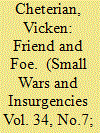

|
|
|
|
|
| Summary/Abstract |
The interaction between Russia and Turkey since 2015 suggests a new quality in foreign affairs combining tactical alliance and strategic competition. The Russian invasion of Ukraine did not change this. By studying the cases of Syria, Libya, and Nagorno-Karabakh, we observe not only elements of geopolitical competition and cooperation but also that the combination of the two contradictory approaches in foreign affairs created new opportunities beneficial to the two sides. Russian-Turkish interactions are a unique case study in international relations and are conditioned by their geopolitical competition with the west, a fact that the war in Ukraine did not alter.
|
|
|
|
|
|
|
|
|
|
|
|
|
|
|
|
| 5 |
ID:
192654
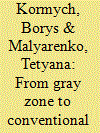

|
|
|
|
|
| Summary/Abstract |
A gray zone conflict that emerged after the Russian annexation of Crimea was an element of the Russian strategy of establishing and consolidating a new and more favourable internationally recognized maritime order in the Black Sea, Kerch Strait, and the Sea of Azov. Empirical data shows that Russian superiority over Ukraine and inferiority vis-a-vis the West shaped a double asymmetry of its tactics of projecting power against Ukraine while avoiding confrontation with the West. Eventually, Moscow reached a point where the gray zone tactics could not secure its objectives. The Russian invasion of Ukraine in February 2022 signalled the exhausting coercive potential of a gray zone conflict. Although, despite of transition to conventional warfare, we found continuity of ‘gray zone’ tactics of double asymmetry and denying responsibility in the Russian playbook. Hence, a possible de-escalation of the Russia – Ukraine war may likely return to a gray zone conflict.
|
|
|
|
|
|
|
|
|
|
|
|
|
|
|
|
| 6 |
ID:
192653
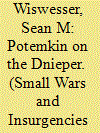

|
|
|
|
|
| Summary/Abstract |
Russia’s airpower failure in the Ukraine war was due to incompetent air campaigning and execution, coupled with the success of a highly effective Ukrainian ground-based air defense. The Russian Air Forces (VKS) attempted to execute what they term a ‘Strategic Air Operation’ based on a ‘non-contact’ doctrine, articulated widely in recent years. But they could not achieve this in practice. As a result, like the famous Potemkin Village of Catherine the Great’s time, Russia’s Air Force today is only a façade of a modern twenty-first-century Air Force. Throughout the first eight months of the invasion, Russia failed to achieve air superiority, failed at suppression of enemy air defense, and failed to deny the use of airpower to its adversary. The absence of Russian airpower was prominently on display during the September 2022 counterattack in the Kharkiv area, where Ukraine took back 3,000 plus square miles of its territory and again with the counteroffensives in the south, where Ukraine retook Kherson. This paper explores both the ‘how’ of Russia’s airpower failure along with ‘why’ it could not execute its own stated doctrine.
|
|
|
|
|
|
|
|
|
|
|
|
|
|
|
|
| 7 |
ID:
192657
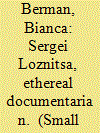

|
|
|
|
|
| Summary/Abstract |
On 24 February 2022, Russia launched a full-scale invasion of Ukraine in a major escalation of a war that had been persisting since 2014. This article explores three of Sergei Loznitsa’s films set in Ukraine and examines the way in which their shared observational style informs the Russia-Ukraine war and may influence viewers’ perceptions of the complexities of the conflict. A close analysis reveals that the observational mode used in Maidan (2014), Donbass (2018), and The Kiev Trial (2022) has two primary effects. First, in Donbass and The Kiev Trial, the unfiltered style serves as a contrast to the often farcical and ‘staged’ content, thereby exposing the lies underpinning Soviet presence in Ukraine and the current Russian invasion. Second, in addition to exposing Russian misinformation, Loznitsa’s observational style in Maidan and Donbass facilitates identification with the Ukrainian people by visually and auditorily immersing the viewer in the world on the screen. The article concludes with a discussion of the significance of Loznitsa’s work in shaping the public’s perception of – and continued commitment to – the war in Ukraine.
|
|
|
|
|
|
|
|
|
|
|
|
|
|
|
|
|
|
|
|
|